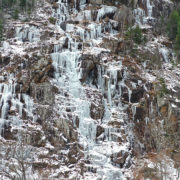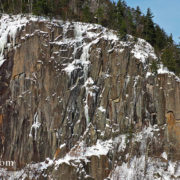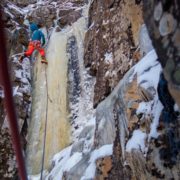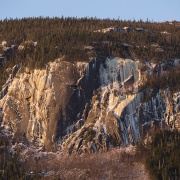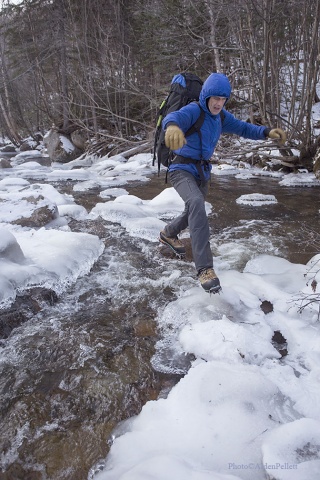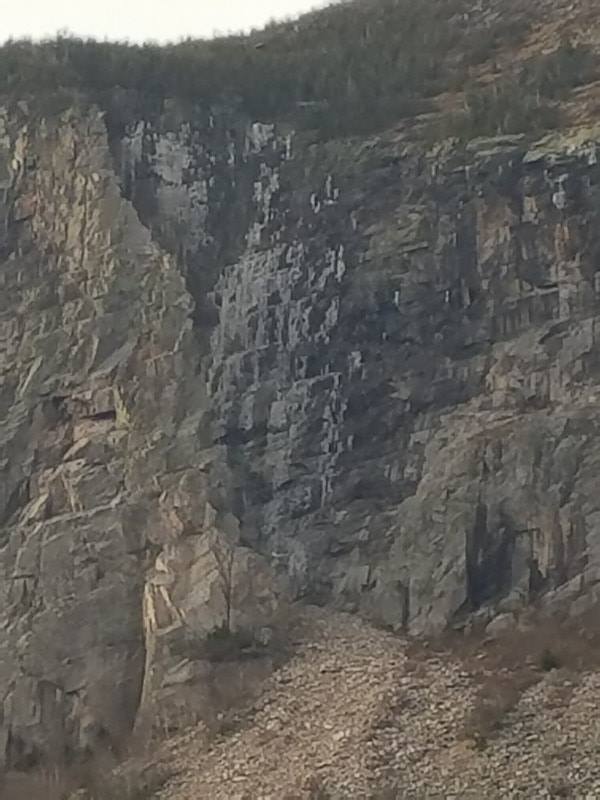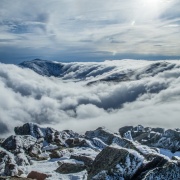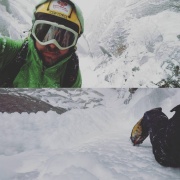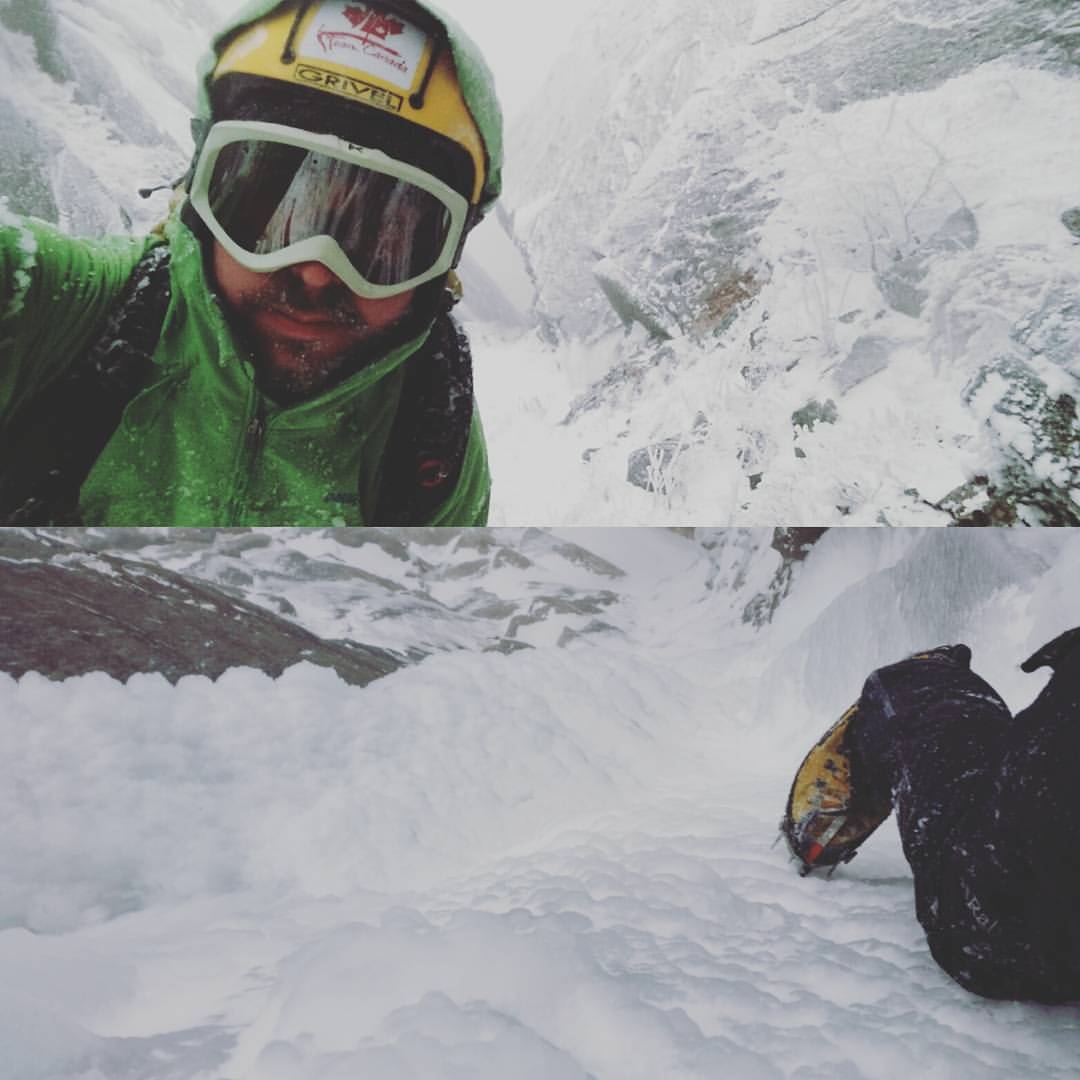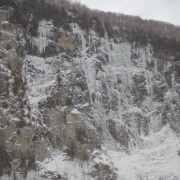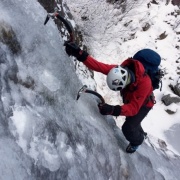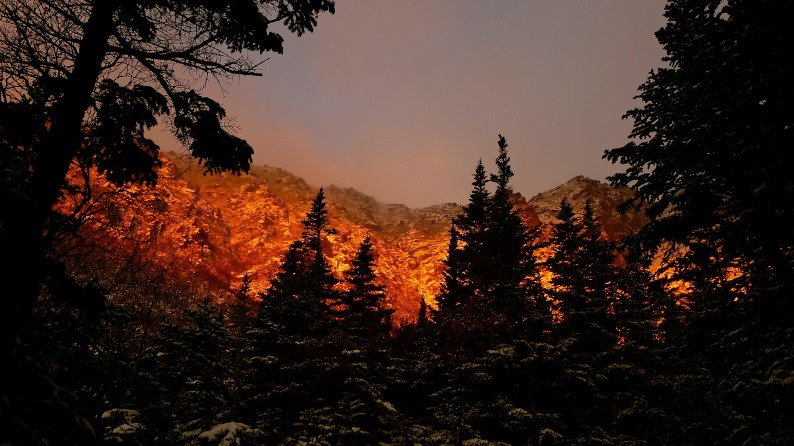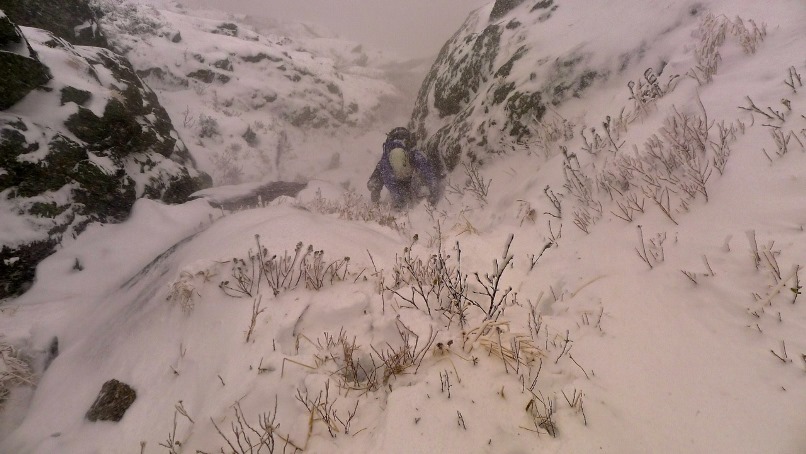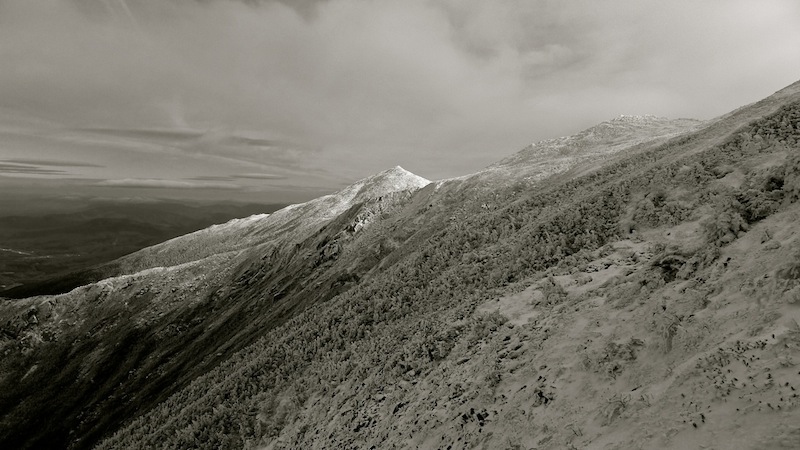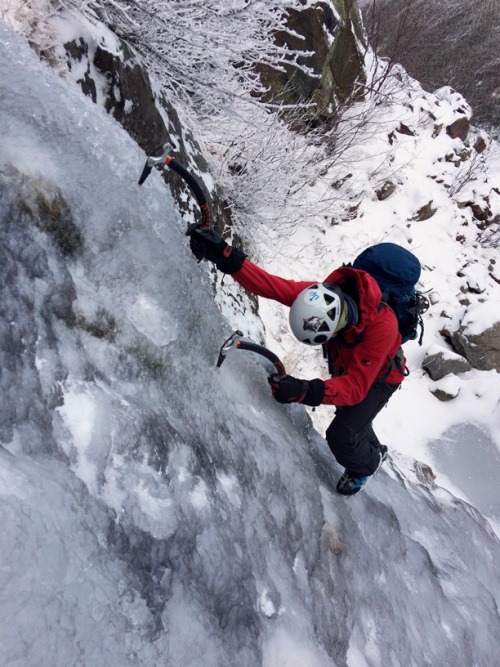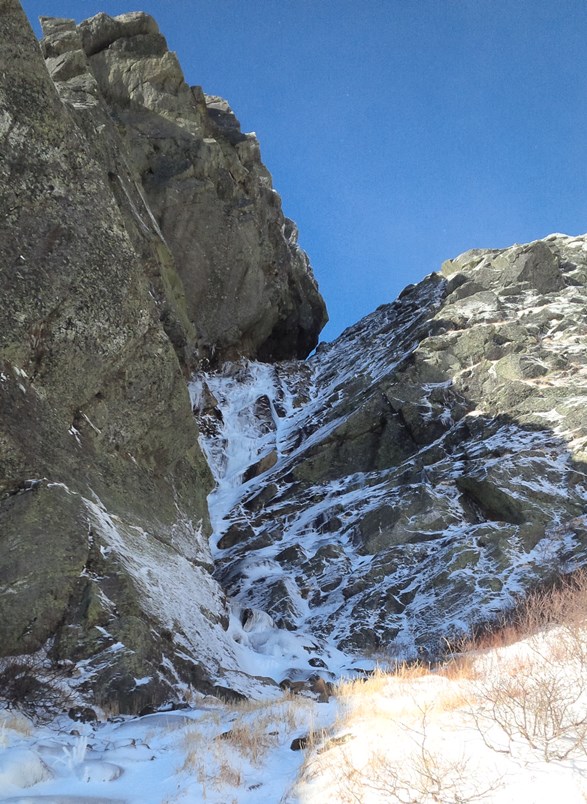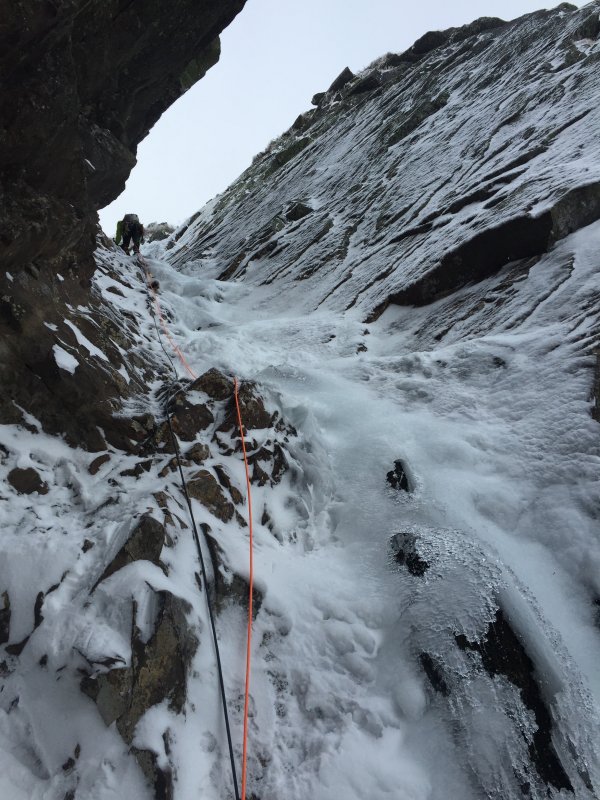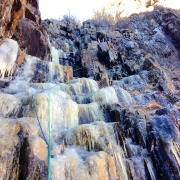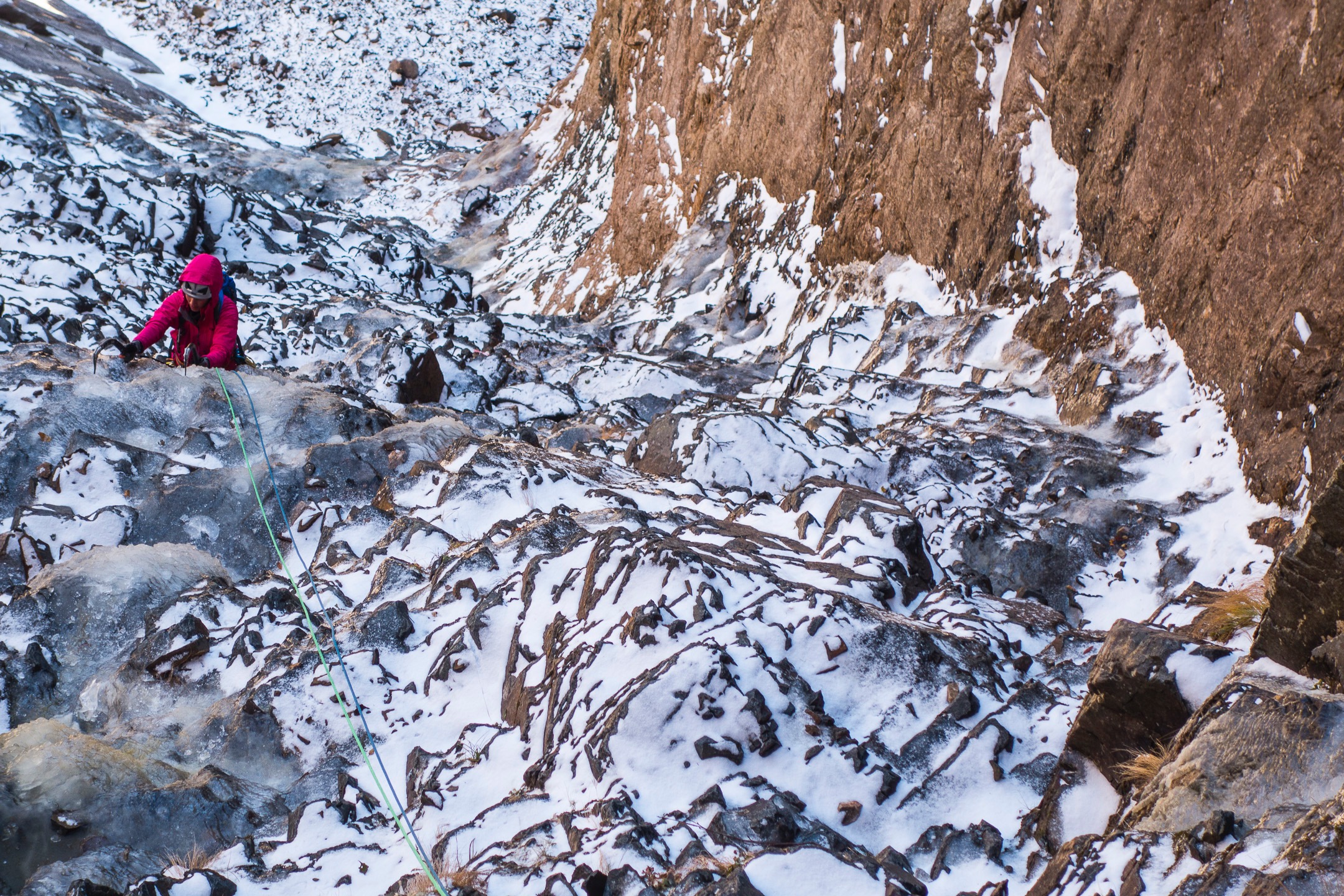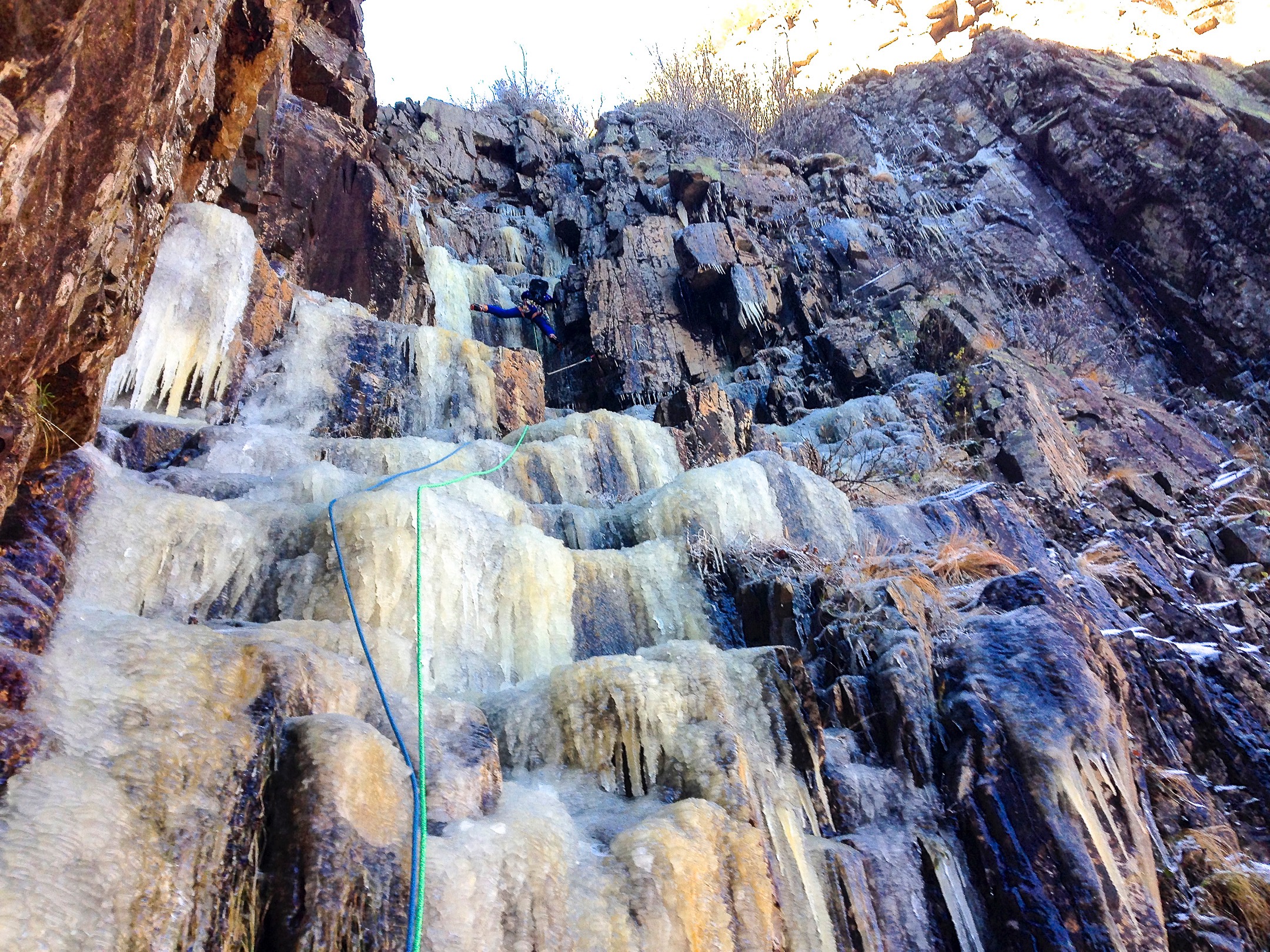Climbers racing the sun on the Bragg-Pheasant
/0 Comments/in Early Season Ice, Featured Stories, Front Page, UP, Video, Video - Featured/by NEice AdminPeter Doucette of Mountain Sense Guides and Mike Houser racing the sun on the Bragg-Pheasant / Frankensteins South Face, Crawford Notch NH
11/24/18
The Black Dike 10-26-18
/0 Comments/in Early Season Ice, Featured Stories, Front Page, Ice Climbing News, The Black Dike/by NEice AdminFinding Balance
An October ascent of the Black Dike is rare, but it is just as rare to find a good balance in your life. Family, work and following your passions. The Doucette / Burhardt family is right on track. After a late night speaking event and the morning logistics of two young children, Peter and Majka still managed to pull off the coveted first ascent of the Black Dike this season. A 10am start “delivered the goods” for them. Another experienced party with an earlier start, backed off the climb that morning. The Black Dike is not in by normal standards and the little window that was there has passed. The ascent is a testament to their ability and balance in their lives.
Find out more on Majka from her website www.majkaburhardt.com/
Photo by Peter Doucette, Mountain Sense Guides
Go North, Old Man!
/2 Comments/in Early Season Ice, Featured Stories, Trip Reports/by AldenA Trip Report
Parc National des Grand Jardins in Quebec
by Alden Pellett
Ice the size of suitcases crashed down the face in the hot sun. I hunkered below a rock buttress, standing off to the side of 20 Below Zero gully. I had just gotten down off a neighboring route and the sun was increasing in intensity. It was only the middle of November, but I was already climbing classic lines at Lake Willoughby!
At the same time around the Northeast, fellow climbers were also ecstatically sinking tools into early season classic ice like the Black Dike at Cannon cliff in New Hampshire, Grand Illusion in Vermont’s Smuggler’s Notch, and Chouinard’s Gully at Chapel Pond in the Adirondacks. The ice had formed excitingly fast over the past few days.
I stood chewing on a crushed peanut butter sandwich. My crampons scratched on the bare ground. Boom! An acrid smell filled the air as a toaster-sized rock crashed down the slope fifty feet away. It felt more like March than November. Now, right before my eyes, the season seemed to be deteriorating almost as rapidly as it started. I quickly packed my lunch away, grabbed my gear, and hustled through the fallen leaves down to my car.
Back at home, a day had gone by. The forecast did not look good. It was clear that the temperatures at lower altitudes meant some of my favorite climbs hadn’t stuck around. I was given an amazing early taste of winter and was depressed at the thought of having to go back to merely dreaming of steep ice. I fired up the wood stove and sunk into my couch, aimlessly browsing social media. Trump, ‘snowflakes,’ North Korea, gun control, blah, blah, blah. None of it seemed to matter. I wanted my ice climbing back, and my out-of-shape, old-man calf muscles from the past couple of days climbing weren’t helping me forget it.
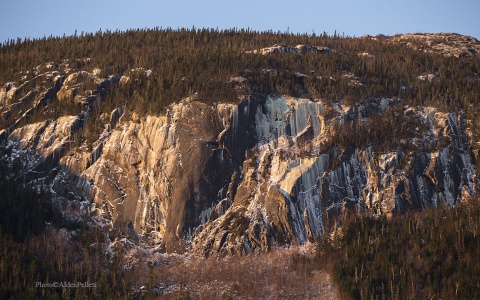
The Mur des Crapaud Wall in Parc National des Grand Jardins in Quebec. Photo by Alden Pellett
Suddenly a glimmer of hope flashed across my computer screen. A Canadian friend to the north posted photos from his own weekend outing. The big crags in the background of some of his pictures had long runnels of shaded ice snaking over five hundred feet down the faces. In another image, steep yellow ice flowed several hundred feet down to talus and trees. I had seen these classics in the ice guidebook for Quebec, but would the ice still be there? Smiling faces in his warm, sunlit photos told me, ‘No,’ but hope flickered there. I checked the forecast. I sent a message. I read the guidebook. I sent another message. I got up and put another log on the fire and sat forward on the couch. His answer came. It was “Yes!” The climbs should still be there! My fingers working quickly, I sent one more message and my buddy Ryan replied. He had time off too and was game for heading north. We would escape this warm up by driving north of the border.
The Parc National des Grand Jardins (Great Gardens) lies about an hour north of Quebec City, traveling through farm country to the quaint tidy town of Ste.-Urbain. This 120-square mile park is loaded with boreal forest, wildlife, tundra, and scenic granite faces.
Wednesday morning, the alarm goes off at our Motel in Baie St. Paul. Ryan fires up the Jet Boil to make hot tea for the day ahead. We had arrived at 9 p.m. the night before, spending an hour sharpening tools and prepping gear before hitting the hay. After wolfing down a speedy breakfast at the ubiquitous Tim Horton’s, we were chomping at the bit to hit the park and see if our chosen routes were still in. I point my old green Toyota van out Highway 138 and start out of the valley. Farms like patchwork dot the way. Dairy cows line up for morning milking, standing in a green hillside pasture grooved from decades of this daily ritual. Passing through the tidy town of St. Urbain, we take a left on 381, winding uphill toward the park. Encouragingly, the early light of day reflects off small ice flows in the hillsides. Straight ahead, our goal, the beautiful granite dome of Mont Gros Bras, ‘The Big Arm,’ comes into sight. Easily viewable from the highway, I slow down, and Ryan cranes his neck to look at the big face. It was Game On! Now all we had to do was see if we dared climb the thinly iced corners.
- You reach the start of the classic mixed routes on Mont Gros Bras by taking a trail across the road and slightly downhill from the Visitor’s Center. Microspikes are helpful right now for crossing the brook and walking uphill on the frozen, leaf-strewn path. The approach seems like it will take longer from the parking lot, but just ten to fifteen minutes of hiking should take you below the big corners and mixed lines there.
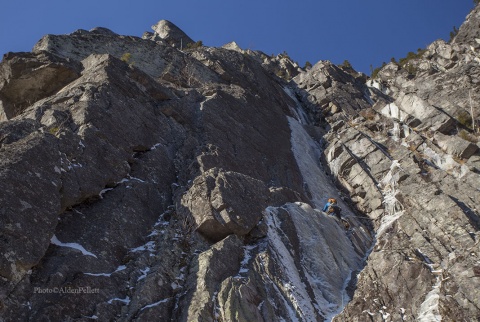
Ryan Stefiuk leading up pitch 1 of P’tite Tête, WI4+R,M6R, on Mont Gros Bras in Parc National des Grand Jardins in Quebec.. Thanks to thin ice, we found the guidebook rating was harder than the actual conditions we encountered. Easy mixed and thin ice at 4+R. Photo by Alden Pellett.
According to Guides des cascades de glace et voies mixtes du Quebec by Stephane Lapierre and Bernard Gagnon:
Mont Gros Bras
Notable winter routes:
“P’tite Tête,” WI4+R,M6R. 175M.
“Gaston et mademoiselle Jeanne,” WI4,M5R. 180M. Just to the right of the previous route.
“All Fine,” WI4+,M5R. 180M. This is the left-hand side of these obvious corner systems in the central part of the cliff.
“Hals und Beinbruch,” M6+. 230M.
Mur des Crapauds
Approach: Cross the road next to a yellow ‘500M’ truck sign, and look for orange contractor tape marking a route through the woods, crossing the brook, and then trending up the right of the talus field below the main cliff face. The woods above get fairly dense and steeper the closer to the cliff you get. This appears to be the easiest path to and from the cliff face. Trust me, we didn’t come down that way and it was a nasty bushwhack.
Notable winter routes:
“Convention Collective,” WI4+R. 90M
“La Retour des Crapauds (Return of the Toads),” WI5+R. 130M
There are a number of appealing corners of thin ice, turf, and mixed corners that have been climbed to the right of this route.
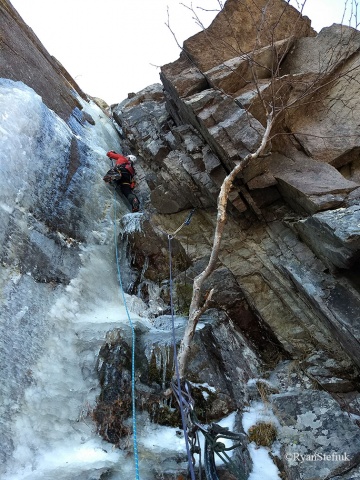
Alden Pellett leads up pitch 2 of the mixed route, “P’tite Tête,” on Mont Gros Bras in Parc National des Grand Jardins in Quebec.
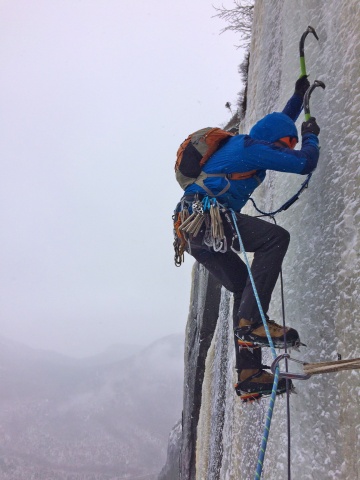
Ryan Stefiuk heads up the crux headwall on “Retour des Crapauds”(Return of the Toads) on the Mur des Crapauds Wall.
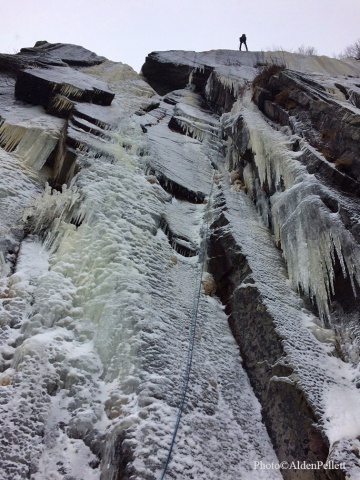
Pitch one of the ice climb “Retour des Crapauds.” in Parc National des Grand Jardins. It gets a WI5+R in the guidebook. We found conditions much easier, more like WI4+(WI4R).
Where to eat and sleep:
There are places for lodging in St. Urbain but we chose to stay near the bigger town of Baie St. Paul for a better selection of restaurants and services.
Baie St. Paul
You can spend between $75 to over $156CDN per night.
Hotel des Cascades – Offers what is probably the most inexpensive night’s lodging. No frills but clean and right near downtown. Recently redone rooms.
Hotel Baie St. Paul – Much along the same vein as des Cascades. Inexpensive but fairly clean and near enough to downtown.
Hotel and Spa Le Germain Charlevoix – Pricey, but pretty inclusive. Restaurants onsite and more.
Tim Hortons for a quick breakfast, of course. it is just down the main drag in town. There is a McDonalds, too. Check out a few of the local restaurants if you have time for a sit-down breakfast.
Joe Smoked Meat – Pleasant interior. Good inexpensive sandwiches on the menu plus a spaghetti plate with sauce. Get it with the smoked meat plate if you want a good but different-looking meal. 😉
There are a number of very nice eateries along the Rue Ste. Jean Baptiste in town like Le Cafe des Artistes. Check them out!
Area Map
* Zoom, Scroll and click Icons for Information & Driving Directions
You might also like this post by Ryan Stefiuk: A Road Trip – Newfoundland 2015
Conditions Update! 11.10.17
/0 Comments/in Conditions, Early Season Ice, Featured Stories/by Courtney LeyNew Hampshire
We had some eyes on the condition of two early season prizes in on Wednesday the 8th! A close look at Pinnacle Gully revealed some unconsolidated and thin, but hopeful, frost and ice. No rock pro options that morning led to a ‘No Go’, but with temperatures remaining frigid, it may be climbable soon! I’m sure the motivated will head into Huntington Ravine this weekend.
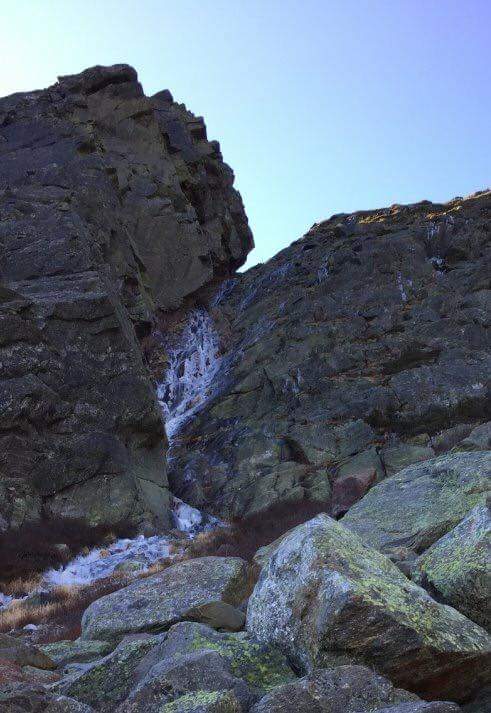
Pinnacle From Afar (11.8.17) . Photo: Gary Reuters
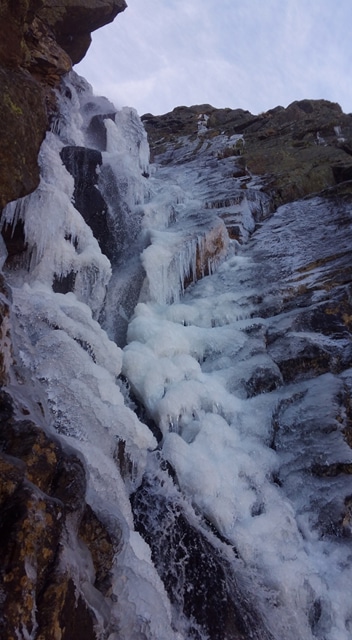
Pinnacle Up Close (11.8.17) . Photo: Gary Reuters
No doubt Cannon Cliff will get a close inspection as well. We have a ‘from-the-road zoom in’ to the dike area and Fafnir. Who will be enticed to take a walk up and peer around the corner?
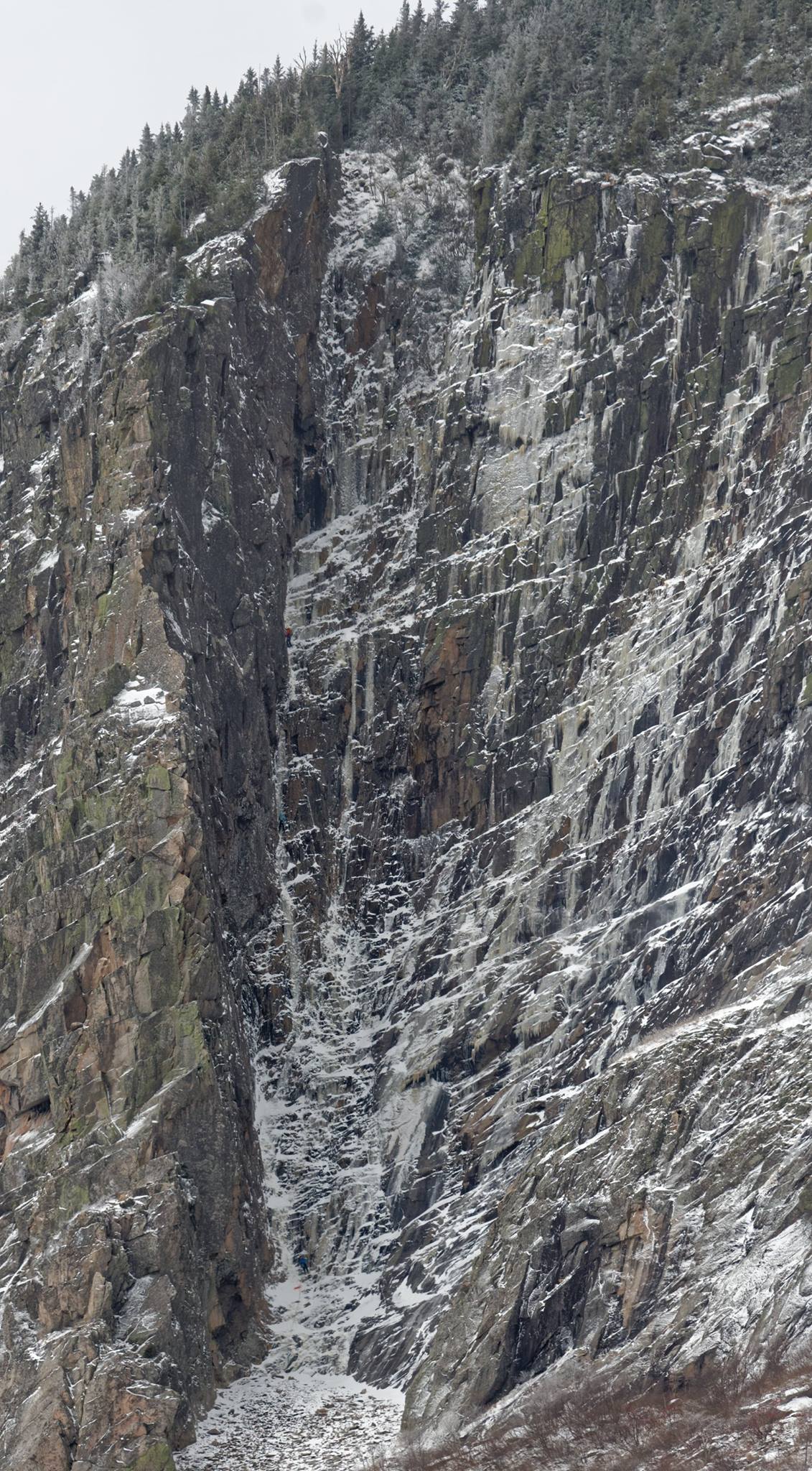
The second follows the runnel pitch on an early season ascent of the Black Dike. 11-10-17 / www.facebook.com/CannonCliffFranconia/
Vermont
In Vermont, it’s currently snowing on the higher peaks and I know a few climbers who only need a millimeter of ice on the cliffs of Smuggler’s Notch to make it go.
New York
A look at our Instagram feed shows crampons to ice! @willclimbz posted a sweet pic of Slide 1 on Whiteface in ‘Thin But In’ conditions. Right on!
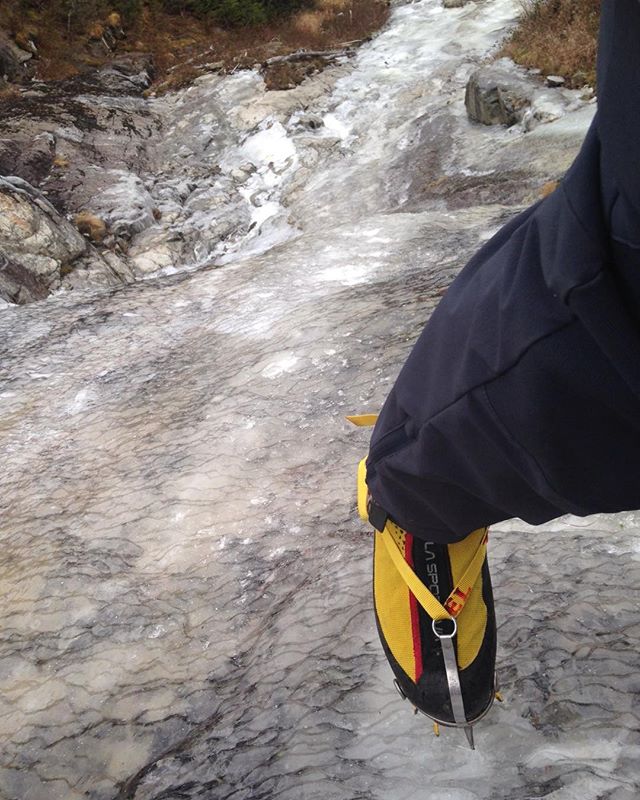
Slide 1, Whiteface. Photo: Will Roth
We certainly had some warm temperatures in October and my usual Halloween ice was far from happening this year. Now temperatures are remaining below freezing up high for a few days leading into the weekend. Finally! Hope to see some great photos and reports of ascents coming in. Have a great weekend!
The Expected and Unexpected of Early Season
/3 Comments/in Early Season Ice, Featured Stories, Ice Climbing News/by Courtney LeySplashing through the rushing water currents on the trail did not invoke confidence that anything would be frozen up higher. Still, my climbing partner and I did not slow our pace into King Ravine. We climbed over the countless snow covered boulders trying not to slip into the human eating crevasses as we picked our way towards Great Gully. It was warm and wet. By the time we started our final approach to the drainage in low visibility, I had already resigned to the fact that we would be just out for a hike inside the low lying cloud bank. To no surprise, Great Gully was a mess of rushing water and soft snow.
[singlepic id=731 w= h= float=center]The floor of the ravine in the clouds. (photo by Joel Dashnaw)
If you are like me, you can’t choose your days to go climbing. I’m chained to a desk Monday through Friday and on some weekends I’m working my second job as a photographer. This particular weekend, I only had Sunday free. So despite the rain on Saturday and rising temperatures, I found myself clinging to the desperate hope that the ice that existed a few days before would still be hanging on. It was a tradition for me to get out and climb ice on Halloween weekend. Rather, get out and attempt to climb ice.
Related Post: Chronicles of the Overly Motivated
I love everything that goes along with being back inside winter’s grip. Although nothing is as good as having your mind and body back on some frozen water for the first time, there’s always more to it. It’s time spent with your climbing partners, or time spent solo. It’s time spent preparing and getting the psych up. It’s about throwing yourself back out into harsh elements. It’s about being in the mountains. On this day, we post-holed through upwards of three feet of blown-in snow as we neared the lip of the ravine. (The type of snow that has that layer of crust that may or may not hold your weight.) We stumbled, stammered and literally crawled our way upwards. We weren’t going to climb an ice-choked gully that day, but we were determined to reach the top regardless. As we were about halfway up the headwall, the clouds began to fade and a brilliant blue sky revealed itself.
[singlepic id=740 w= h= float=center]Leaving the clouds behind us. (photo by Courtney Ley)
Any thought of ice I had was left below me inside the cloud bank. We weren’t out there anymore to find ice to climb, or lamenting it didn’t exist that day. We were thrilled to experience one of the most outstanding undercasts I’ve ever seen. Most years, my early season tradition of just ‘going out there anyway’ finds a reward for me. Some years it’s ice to climb. Other years, it becomes something completely unexpected.
Photographs by Joel Dashnaw and Courtney Ley
Solo's First Trip to "The Lake"
/0 Comments/in Early Season Ice, Featured Stories, Front Page/by NEice AdminWe have been waiting for winter and it is here! The ice is building and with very cold weather coming things are going to go OFF! Next weekend should bring great conditions to most climbing areas.
This was Solo’s first trip to “The Lake” and everything went well. He was not intimated by the size of the ice climbs and can’t wait to return.
Here are a few photos from our flights.
Weekly UPdate – November Rations
/1 Comment/in Conditions, Early Season Ice, Featured Stories/by NEice AdminOn the day of the Black Dike ascent on October 19th, I was in Huntington Ravine to scope out what, if anything, had formed after only two days of below freezing temperatures. I chose a winding line up Yale Gully, avoiding the slab sections that had a coating of ice that was almost immeasurable to the human eye. Thin runnels of ice over rocky grooves kept me engaged and deep snowy drifts clinging to the upper sections made for a great winter day in mid-October. I wouldn’t say it was ‘first ice’ for me that day, but the adventure was well worth the effort.
After that weekend, the brief shot of winter died off and the thermometer climbed back up. For more than two weeks after, above average temperatures killed any hope for more ice. Tools and spikes were sharpened and ready to go. We all waited impatiently for that next cold spell.
Winter tried again to beat back this warm Autumn with another two days of bitterly cold weather and high winds this past Friday and Saturday. And for those of us who went out on Sunday, we made that approach thinking it’s a 50/50 chance of climbable ice, at best. Were we just a bunch of dedicated fools? Perhaps.
I rolled the dice in King Ravine, usually a good early season bet. Zac St. Jules walked alone into Huntington Ravine as Max Forbes with his team, Russell Frisch and Steve Rahr started their own approach into the ravine under windy skies and cold morning temperatures. King Ravine was ready for me. My first swing into the drainage ice of the Great Gully was thin but sticky. Water was flowing underneath the ice, leaving a fountain at times where my pick had been. The ice ranged from just thick enough to almost too thin for comfort but it was secure and a total blast to climb. Above the ice, the snow began filling in the upper portion of the gully. Solid winter conditions greeted me at the top and underfoot I crushed thousands of rime ice feathers.
Meanwhile in Huntington Ravine, the high winds were forcing Zac to fight through some nasty spray from the open sections of running water midway up Pinnacle Gully. At the base of the climb, the party of three were about to head up the committing mix climb above them.
The first pitch was led by Russ Frisch, who placed two screws low and then quickly ran out of ice. Max Forbes took the next lead and found himself having to cross a wide section of running water in the middle of the route. He placed a knifeblade and began moving through the water course. “Since there was not enough ice over the running water to support my weight, I bashed through it with my hammer exposing the running water and rock below. I stepped through the water and did a bit of a jump to get across to solid ground. I moved up a short ramp with 4 inches or so of relatively attached ice and moved up into a small corner to rest. I placed a .2 X4, one of the only solid pieces of the day, and then crossed back over the running water to reach the fixed anchor at the top of Pitch 2.” – Max Forbes
The last pitch was pretty moderate, exclusively mixed climbing with patches of ice and hard snow that provided a bit more comfortable stance. More photos from the day here.
As for the rest of Huntington, Max reports: “O’dells was filling well, and the first pitch looked climbable. Central looked full of mostly snow, some ice at the crux. Yale and Harvard bulges were in pretty fat, but the gullies above were not looking as good. The ice is definitely coming in though. North seemed to have filled in pretty quickly as well, but the start didn’t seem to be there. Hopefully it stays cold up there but it looks like conditions will hold and allow everything to continue to build.”
At the Pitch 2 Belay of Pinnacle Gully on November 15, 2015. by max-forbes
Twenty miles southwest of Mt. Washington, two more climbers were picking at the meager winter rations. Noel Normandin and Ryan Ferry were perched high on the Black Dike, which was dishing out a 90% mix climb. Noel describes the route:
- P1 : Mostly well-bonded, thin unprotected ice.
- P2: Thin ice going up to the rock traverse, then no ice in the hose for 40ish feet. A little ice after the grade eases off, taking a stubby in places.
- P3: Started out on ice, then after a short steep parasol capped headwall turned to mostly loose snow covered rock.
While starting the third pitch, another party was spotted below. Winter is finally getting a hold of the mountains! Keep those metal bits sharpened!
New Hampshire isn’t the only place where ice is forming. I bet some things are going down in NY and VT this week, if they haven’t already!
A wintry mix is forecasted for the higher summits on Friday night with blustery weather and snow moving in over the weekend, the ice season is well on its way! Check out the weather page for more info!
Special Thanks to Zac St. Jules, Max Forbes and Noel Normandin for their photographs, video and additional words.
Burhardt and Siegel Start off the Ice Season with Impressive Ascent
/1 Comment/in Early Season Ice, Featured Stories, The Black Dike/by NEice AdminThe Black Dike
October 19, 2015
The first ascent of the Black Dike on Cannon Cliff each year has always been the herald of the new ice season. This year, it came early and swift!
Yesterday morning, Majka Burhardt and Alexa Siegel worked their way up the route in lean and mean conditions, providing high-quality early ice season stoke. Burhardt led the route and the two were back in the sun at the parking lot at 1:00 pm after a dozen good ice sticks, 40 times that of thin sticks and mixed moves, and two bouts of screaming barfies over three pitches (a piece).
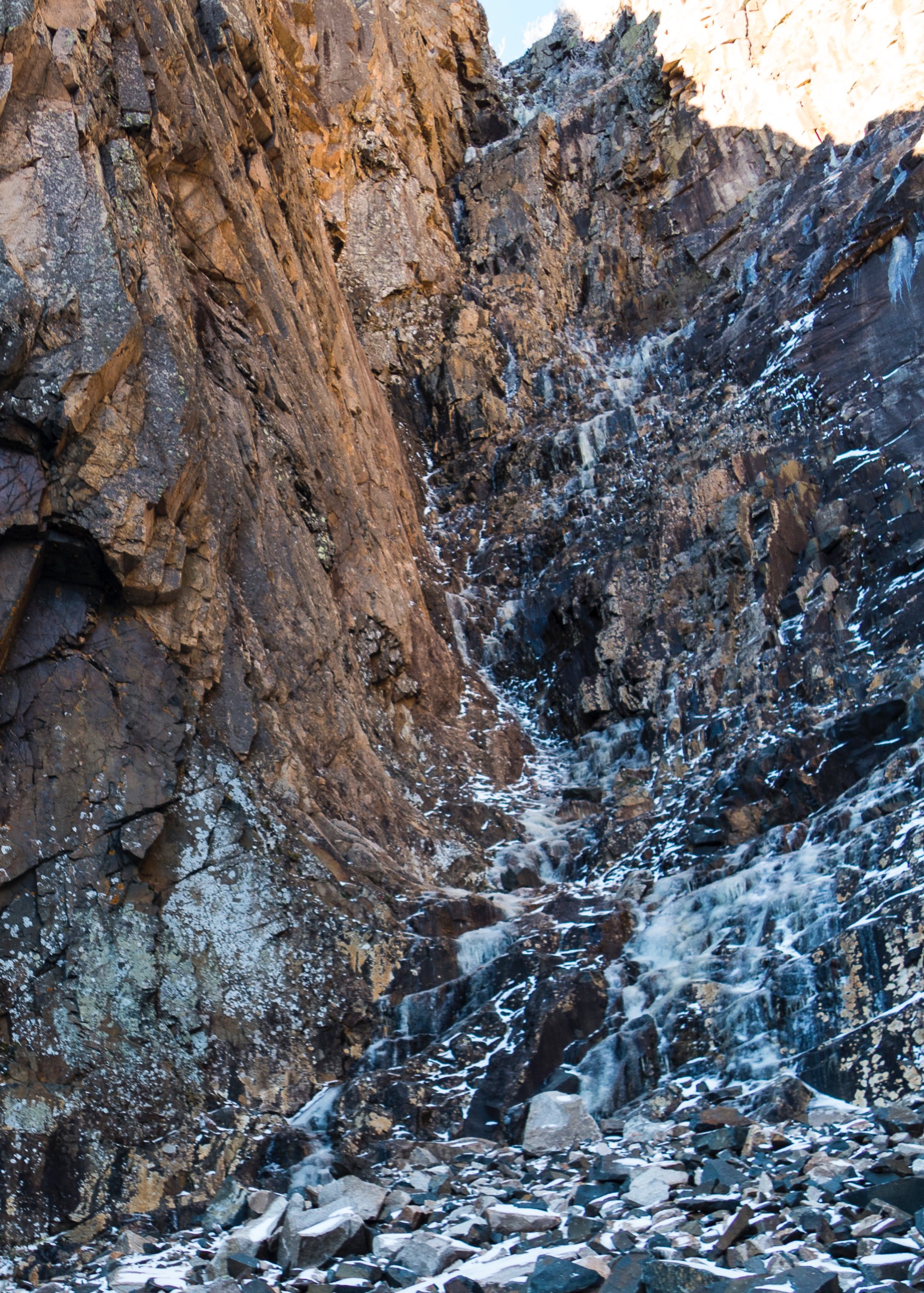
View up the Dike, 7:45 am October 19th and the moment of “Oh yeah! It’s in.” Photo by Majka Burhardt.
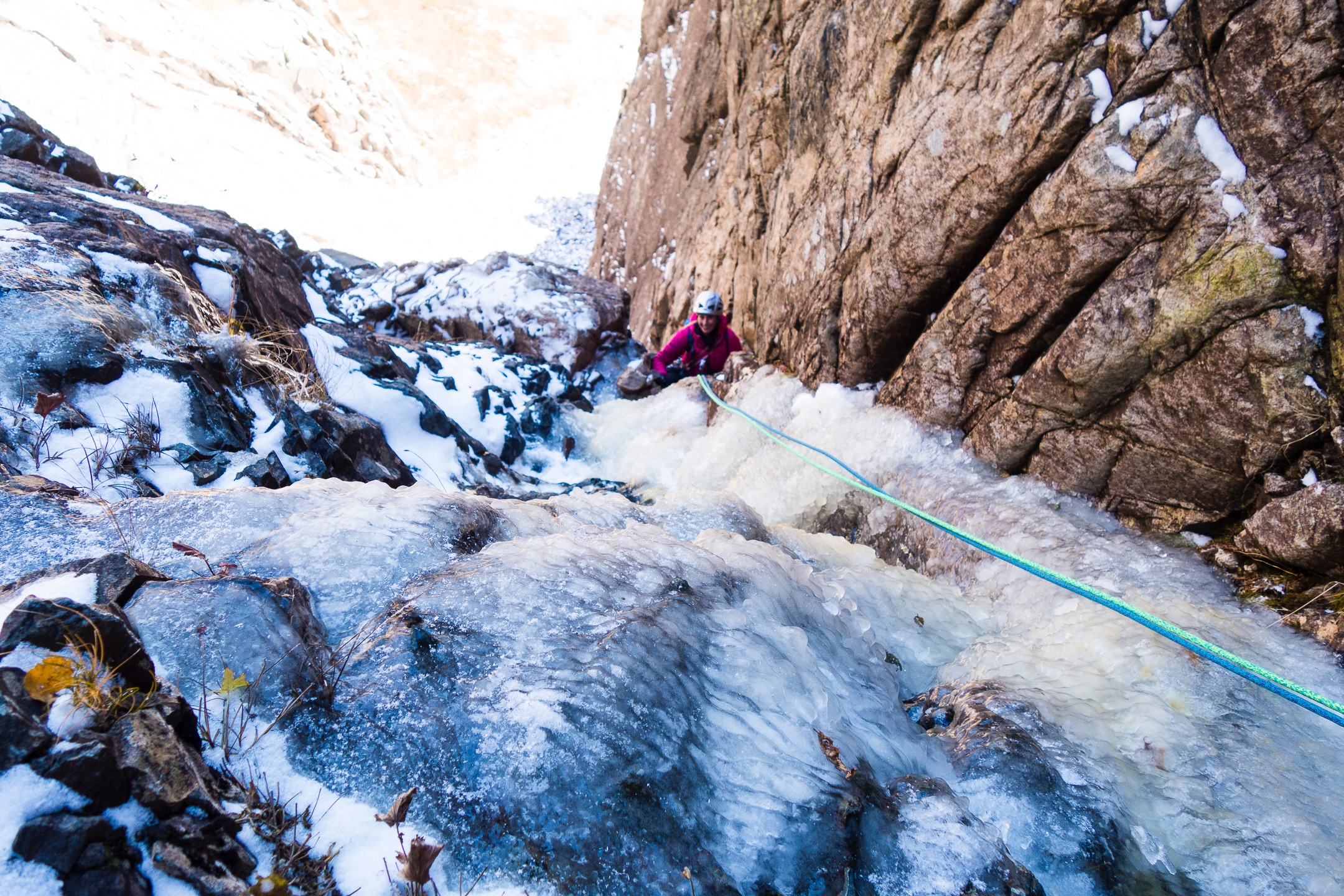
Pitch two was dry on the traverse, a bit of everything in the hose, and sticks up top. Alexa finishes it off. Photo by Majka Burhardt.
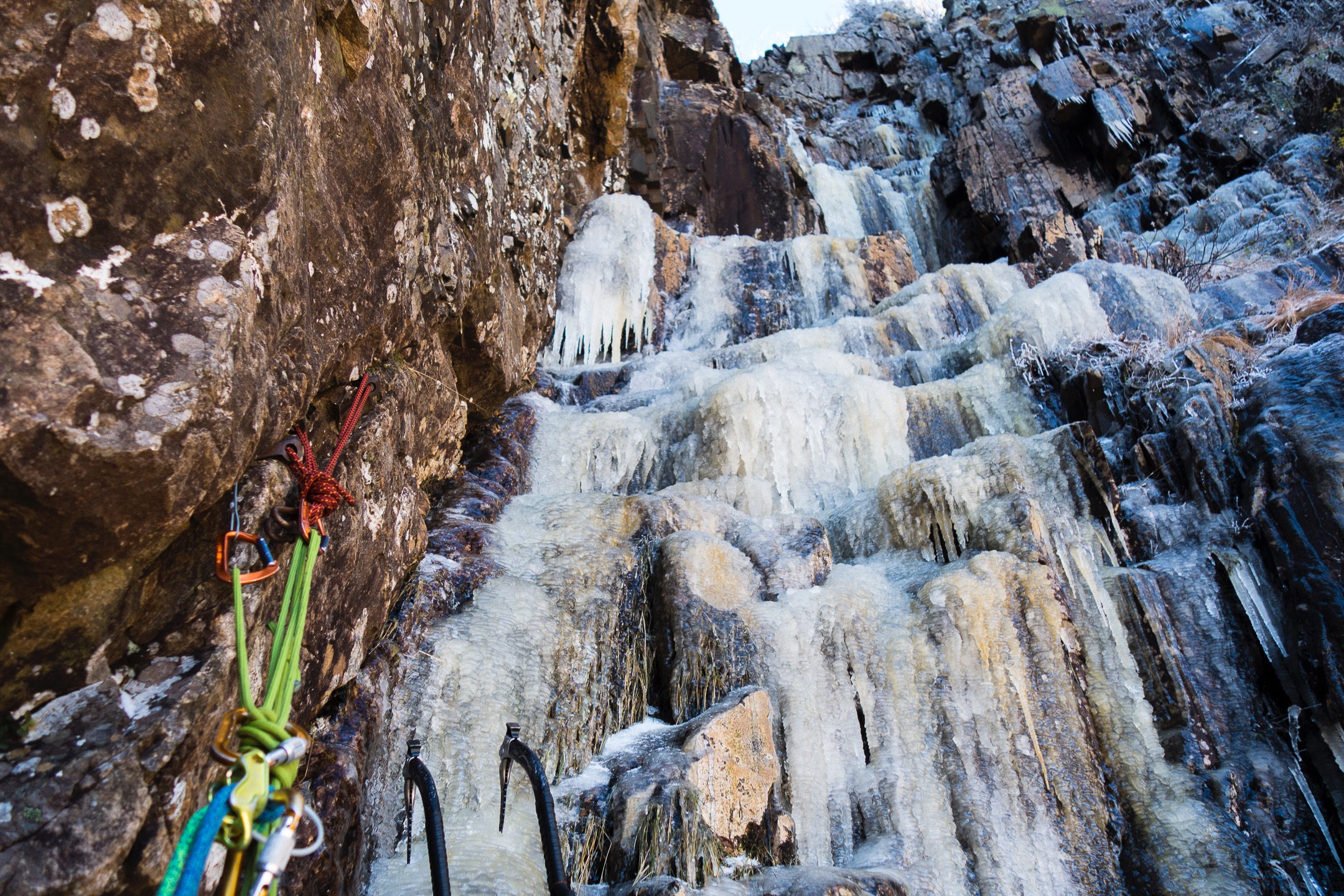
Looking up the final pitch— which (surprisingly) gave the most thoughtful climbing of the three. Photo by Majka Burhardt.
“Ice season is ON— don’t let anyone tell you otherwise.” – Majka Burhardt
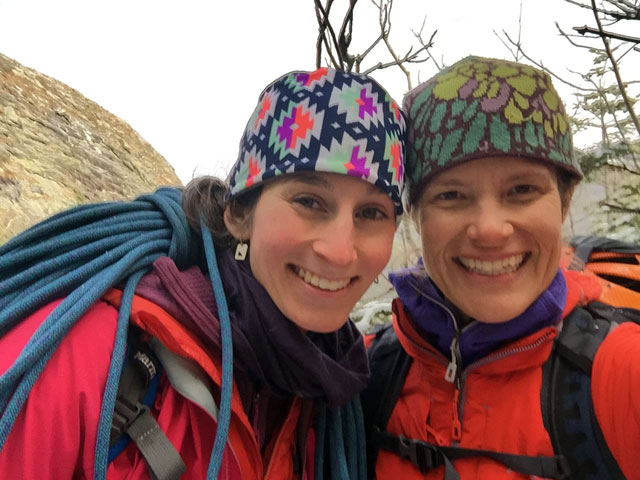 Alexa Siegel works year round as a climbing guide for Cathedral Mountain Guides, Mooney Mountain Guides, The White Mountain Climbing Camp and The Kismet Rock Foundation. Last winter, Janet Wilkinson and Alexa started a Ladies Only Climbing Series with Cathedral Mountain Guides teaching women of all abilities ice climbing and mountaineering skills. She is a grassroots athlete for Outdoor Research and a member of Mountain Rescue Service.
Alexa Siegel works year round as a climbing guide for Cathedral Mountain Guides, Mooney Mountain Guides, The White Mountain Climbing Camp and The Kismet Rock Foundation. Last winter, Janet Wilkinson and Alexa started a Ladies Only Climbing Series with Cathedral Mountain Guides teaching women of all abilities ice climbing and mountaineering skills. She is a grassroots athlete for Outdoor Research and a member of Mountain Rescue Service.
Majka Burhardt is an author, professional climber, filmmaker, and the founder/director at Additive Adventure. She is an ambassador/athlete for Patagonia, Osprey Packs, Positive Tracks, Petzl, Scarpa, and Julbo and an American Mountain Guides Association Certified Rock Guide.
Find Majka at www.majkaburhardt.com and follow her at https://instagram.com/

North East Ice
Your ice climbing connection for New England, the Northeast and Beyond!

